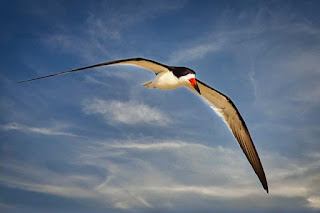We are approaching the end of the nesting season and the bird posting has been pretty quiet.
Last Wednesday, 8/18, one of our Wrightsville Beach Bird Stewards, Candance Gauthier wrote this summary after her time at the south end.
“I was at the beach last night from 6 PM until 8:15 PM. I went around the long way and was getting worried since I didn't see any birds for a long time. Around the point, I saw about 30 Black Skimmers coming off the water at Banks Channel. I saw one fledgling with them.
I found TEX alone on that side, too…just walking around on the sand. Doubling back, I finally located one last Black Skimmer juvenile past the point, on the Inlet side. He was sitting or walking on the beach by the vegetation, being protected by 3- 5 adults who were diving at me when I got too close. I stayed with him and saw him try to fly but he wasn't quite ready.
Later, I walked back around the point to check on Tex (banded ETX). I found him with his parent and they were walking around and finally they both took off, flying over the point toward the Inlet.
 |
| photo by Camille Daniels |
 |
| photo by Camille Daniels |
 |
| photo by Camille Daniels |
 |
| photo by Camille Daniels |
 |
| photo by Camille Daniels |
 |
| photo by Camille Daniels |
 |
| photo by Camille Daniels |
BLACK SKIMMERS
As Candace mentioned above, we had one remaining Black Skimmer chick that was seen regularly at the point of the nesting colony protected by 3-4 adult Black Skimmers. Then on Tuesday, 8/25, several Bird Stewards came across the Black Skimmer juvenile near the point on the inlet side. The chick flew several times in response to folks walking down the beach toward him. He flew probably the equivalent of about four posts from the post line on the inlet side to the beach near the water. Then from one side of the point to the other side by the ocean. He took off from there and did a loop through the posting and came back to the beach. Again he flew down the beach to the point. There he spent much of the time pancaked on the sand. The parent(s) chased off gulls several times. So it appears our last chick is ready to "leave the nest".
Our remaining Black Skimmer chick was banded by Lindsay on Tuesday, 8/17.
OYSTERCATCHER
Our young Oystercatcher (banded ETX) aka “Tex” is flying across the inlet to the marsh and learning from its parent how to find and open bivalves, such as razor clams, oysters and mussels.
LEAST TERNS AND COMMON TERNS
Both Least Tern and Common Tern fledglings can often be seen on the beach as they perfect both their flying and fishing skills.



















